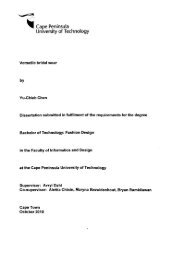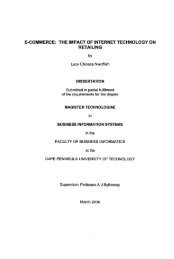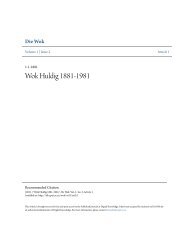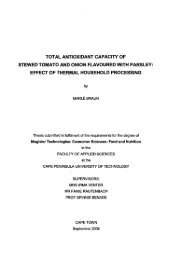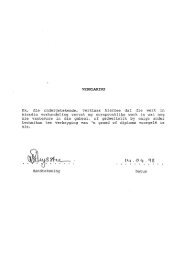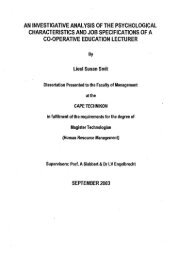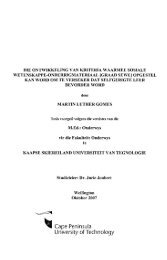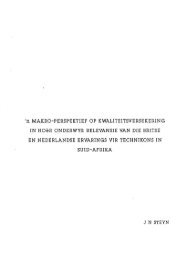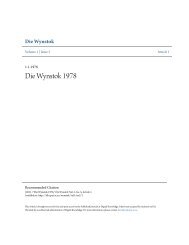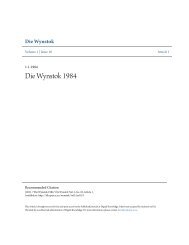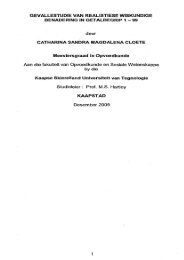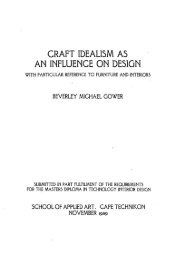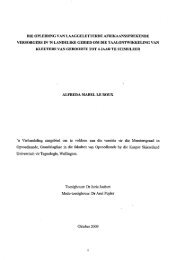the effect of the particle size distribution on non-newtonian turbulent ...
the effect of the particle size distribution on non-newtonian turbulent ...
the effect of the particle size distribution on non-newtonian turbulent ...
Create successful ePaper yourself
Turn your PDF publications into a flip-book with our unique Google optimized e-Paper software.
Chapter 2<br />
2.14.2<br />
Literature Review<br />
Transiti<strong>on</strong> from Laminar to Turbulent Flow<br />
Page 2.44<br />
There are several methods in <str<strong>on</strong>g>the</str<strong>on</strong>g> literature to determine <str<strong>on</strong>g>the</str<strong>on</strong>g> transiti<strong>on</strong> between larninar and<br />
<strong>turbulent</strong> flow. However, <str<strong>on</strong>g>the</str<strong>on</strong>g> full rheology should be used.<br />
2.14.3 Turbulent flow<br />
The Blasius type equati<strong>on</strong>s can be used to determine <strong>turbulent</strong> flow. However, most <str<strong>on</strong>g>of</str<strong>on</strong>g> <str<strong>on</strong>g>the</str<strong>on</strong>g><br />
work to develop semi-<str<strong>on</strong>g>the</str<strong>on</strong>g>oretical models for <strong>turbulent</strong> flow has centred around <str<strong>on</strong>g>the</str<strong>on</strong>g> mixing<br />
length model <str<strong>on</strong>g>of</str<strong>on</strong>g> Prandtl. Hence, <str<strong>on</strong>g>the</str<strong>on</strong>g> logarithmic velocity <str<strong>on</strong>g>distributi<strong>on</strong></str<strong>on</strong>g> can be used to model<br />
smooth wall Newt<strong>on</strong>ian <strong>turbulent</strong> flow. A logarithmic velocity <str<strong>on</strong>g>distributi<strong>on</strong></str<strong>on</strong>g> with a roughness<br />
functi<strong>on</strong> and a roughness Reynolds number to correlate <str<strong>on</strong>g>the</str<strong>on</strong>g> roughness functi<strong>on</strong> can be used<br />
to model fully developed rough wall Newt<strong>on</strong>ian <strong>turbulent</strong> flow. The Colebrook White<br />
relati<strong>on</strong> can be used to model partially rough wall Newt<strong>on</strong>ian <strong>turbulent</strong> flow.<br />
There are three approaches in <str<strong>on</strong>g>the</str<strong>on</strong>g> literature for modelling n<strong>on</strong>-Newt<strong>on</strong>ian <strong>turbulent</strong> flow data:<br />
• empirical approach eg Bowen (1961),<br />
• approach based <strong>on</strong> <str<strong>on</strong>g>the</str<strong>on</strong>g> slurry rheology eg Torrance (1963) or Wils<strong>on</strong> &<br />
Thomas (1985, 1987),<br />
• approach based <strong>on</strong> <str<strong>on</strong>g>the</str<strong>on</strong>g> <str<strong>on</strong>g>particle</str<strong>on</strong>g> <str<strong>on</strong>g>effect</str<strong>on</strong>g> or <str<strong>on</strong>g>particle</str<strong>on</strong>g> roughness <str<strong>on</strong>g>effect</str<strong>on</strong>g> eg Slatter<br />
(1994).<br />
The c<strong>on</strong>tinuum approximati<strong>on</strong> must be compromised as <str<strong>on</strong>g>the</str<strong>on</strong>g> solid <str<strong>on</strong>g>particle</str<strong>on</strong>g>s c<strong>on</strong>tained in <str<strong>on</strong>g>the</str<strong>on</strong>g><br />
slurry are large compared with <str<strong>on</strong>g>the</str<strong>on</strong>g> scale <str<strong>on</strong>g>of</str<strong>on</strong>g> modelling <str<strong>on</strong>g>of</str<strong>on</strong>g> <str<strong>on</strong>g>the</str<strong>on</strong>g> viscous sub-layer thickness.<br />
Theoretical models must <str<strong>on</strong>g>the</str<strong>on</strong>g>refore account for <str<strong>on</strong>g>the</str<strong>on</strong>g> <str<strong>on</strong>g>effect</str<strong>on</strong>g> <str<strong>on</strong>g>of</str<strong>on</strong>g> <str<strong>on</strong>g>the</str<strong>on</strong>g> <str<strong>on</strong>g>particle</str<strong>on</strong>g>s in <strong>turbulent</strong> flow and<br />
hence from <str<strong>on</strong>g>the</str<strong>on</strong>g> three possible approaches that can be adopted, <str<strong>on</strong>g>the</str<strong>on</strong>g> approach using <str<strong>on</strong>g>the</str<strong>on</strong>g> <str<strong>on</strong>g>particle</str<strong>on</strong>g><br />
roughness <str<strong>on</strong>g>effect</str<strong>on</strong>g> should be used. Although Bowen's method does produce good correlati<strong>on</strong><br />
<str<strong>on</strong>g>of</str<strong>on</strong>g> n<strong>on</strong>-Newt<strong>on</strong>ian <strong>turbulent</strong> flow pipe data it cannot provide an explanati<strong>on</strong> <str<strong>on</strong>g>of</str<strong>on</strong>g> <str<strong>on</strong>g>the</str<strong>on</strong>g> behaviour<br />
<str<strong>on</strong>g>of</str<strong>on</strong>g> <str<strong>on</strong>g>the</str<strong>on</strong>g> slurry in terms <str<strong>on</strong>g>of</str<strong>on</strong>g> <str<strong>on</strong>g>the</str<strong>on</strong>g> physical properties <str<strong>on</strong>g>of</str<strong>on</strong>g> <str<strong>on</strong>g>the</str<strong>on</strong>g> slurry.<br />
A wall roughness <str<strong>on</strong>g>effect</str<strong>on</strong>g>, <str<strong>on</strong>g>particle</str<strong>on</strong>g> <str<strong>on</strong>g>effect</str<strong>on</strong>g> or <str<strong>on</strong>g>particle</str<strong>on</strong>g> roughness <str<strong>on</strong>g>effect</str<strong>on</strong>g> has been reported in <str<strong>on</strong>g>the</str<strong>on</strong>g><br />
literature (Maude & Whitmore 1956, 1958, Mun 1988, Slatter 1994). This <str<strong>on</strong>g>effect</str<strong>on</strong>g> has been



